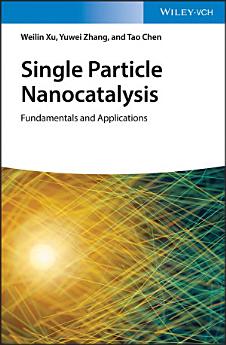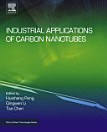Single Particle Nanocatalysis: Fundamentals and Applications
Weilin Xu · Yuwei Zhang · Tao Chen
ફેબ્રુ 2019 · John Wiley & Sons
5.0star
1 રિવ્યૂreport
ઇ-પુસ્તક
304
પેજ
reportરેટિંગ અને રિવ્યૂ ચકાસેલા નથી વધુ જાણો
આ ઇ-પુસ્તક વિશે
Introduces the detailed basis and recent development of single molecule/particle nanocatalysis based on single molecule techniques
This unique book introduces and summarizes the recent development of single molecule/particle nanocatalysis to provide both comprehensive coverage of fundamentals for different methods now in widespread use and the extensive applications in different catalytic systems. Chapters are mainly based on different detection methods, including single molecule fluorescence microscopy, surface plasmon resonance spectroscopy, X-ray microscopy, and surface enhanced Raman spectroscopy. The book also includes numerous basic principles of different methods and application examples and features illustrations that help clarify presentations.
Single Particle Nanocatalysis: Fundamentals and Applications starts with the history and development of single molecule techniques for nanocatalysis. It then shows readers how single molecule fluorescence microscopy (SMFM) reveals catalytic kinetics and dynamics of individual nanocatalysts. Next, it examines traditional SMFM-based single molecule nanocatalysis without super-resolution (SR) imaging, before moving on to the topic of SMFM-based SR imaging in single molecule nanocatalysis. Following chapters cover scanning electrochemical microscopy for single particle nanocatalysis; surface plasmon resonance spectroscopy for single particle nanocatalysis/reactions; X-ray-based microscopy of single-particle nanocatalysis; and surface-enhanced Raman spectroscopy for single particle nanocatalysis. The book finishes by introducing some less-practiced techniques for single particle nanocatalysis/electrochemistry.
-Presents a systematical and complete introduction to the subject of single particle nanocatalysis?covering all of its fundamentals and applications
-Helps readers fully understand the basis, role, and recent development of single molecule nanocatalysis
-Teaches researchers how to gain new knowledge to successfully conduct their own studies within this rapidly increasing new area of research
Single Particle Nanocatalysis: Fundamentals and Applications is an excellent reference book for experts in this area as well as for general researchers who want to learn how to study nanocatalysis at single molecule/particle level.
This unique book introduces and summarizes the recent development of single molecule/particle nanocatalysis to provide both comprehensive coverage of fundamentals for different methods now in widespread use and the extensive applications in different catalytic systems. Chapters are mainly based on different detection methods, including single molecule fluorescence microscopy, surface plasmon resonance spectroscopy, X-ray microscopy, and surface enhanced Raman spectroscopy. The book also includes numerous basic principles of different methods and application examples and features illustrations that help clarify presentations.
Single Particle Nanocatalysis: Fundamentals and Applications starts with the history and development of single molecule techniques for nanocatalysis. It then shows readers how single molecule fluorescence microscopy (SMFM) reveals catalytic kinetics and dynamics of individual nanocatalysts. Next, it examines traditional SMFM-based single molecule nanocatalysis without super-resolution (SR) imaging, before moving on to the topic of SMFM-based SR imaging in single molecule nanocatalysis. Following chapters cover scanning electrochemical microscopy for single particle nanocatalysis; surface plasmon resonance spectroscopy for single particle nanocatalysis/reactions; X-ray-based microscopy of single-particle nanocatalysis; and surface-enhanced Raman spectroscopy for single particle nanocatalysis. The book finishes by introducing some less-practiced techniques for single particle nanocatalysis/electrochemistry.
-Presents a systematical and complete introduction to the subject of single particle nanocatalysis?covering all of its fundamentals and applications
-Helps readers fully understand the basis, role, and recent development of single molecule nanocatalysis
-Teaches researchers how to gain new knowledge to successfully conduct their own studies within this rapidly increasing new area of research
Single Particle Nanocatalysis: Fundamentals and Applications is an excellent reference book for experts in this area as well as for general researchers who want to learn how to study nanocatalysis at single molecule/particle level.
રેટિંગ અને રિવ્યૂ
5.0
1 રિવ્યૂ
લેખક વિશે
Weilin Xu, PhD, is Professor at Changchun Institute of Applied Chemistry, Chinese Academy of Sciences. He focuses on energy process related basic and practical research.
Yuwei Zhang, PhD, is Associate Professor at Changchun Institute of Applied Chemistry, Chinese Academy of Sciences. Her research is currently on single particle nanocatalysis.
Tao Chen, PhD, obtained his PhD from Changchun Institute of Applied Chemistry, Chinese Academy of Sciences, where he studied the nanocatalysis at single particle level based on single molecule fluorescence spectroscopy.
આ ઇ-પુસ્તકને રેટિંગ આપો
તમે શું વિચારો છો અમને જણાવો.
માહિતી વાંચવી
સ્માર્ટફોન અને ટૅબ્લેટ
Android અને iPad/iPhone માટે Google Play Books ઍપ ઇન્સ્ટૉલ કરો. તે તમારા એકાઉન્ટ સાથે ઑટોમૅટિક રીતે સિંક થાય છે અને તમને જ્યાં પણ હો ત્યાં તમને ઑનલાઇન અથવા ઑફલાઇન વાંચવાની મંજૂરી આપે છે.
લૅપટૉપ અને કમ્પ્યુટર
Google Play પર ખરીદેલ ઑડિઓબુકને તમે તમારા કમ્પ્યુટરના વેબ બ્રાઉઝરનો ઉપયોગ કરીને સાંભળી શકો છો.
eReaders અને અન્ય ડિવાઇસ
Kobo ઇ-રીડર જેવા ઇ-ઇંક ડિવાઇસ પર વાંચવા માટે, તમારે ફાઇલને ડાઉનલોડ કરીને તમારા ડિવાઇસ પર ટ્રાન્સફર કરવાની જરૂર પડશે. સપોર્ટેડ ઇ-રીડર પર ફાઇલો ટ્રાન્સ્ફર કરવા માટે સહાયતા કેન્દ્રની વિગતવાર સૂચનાઓ અનુસરો.





